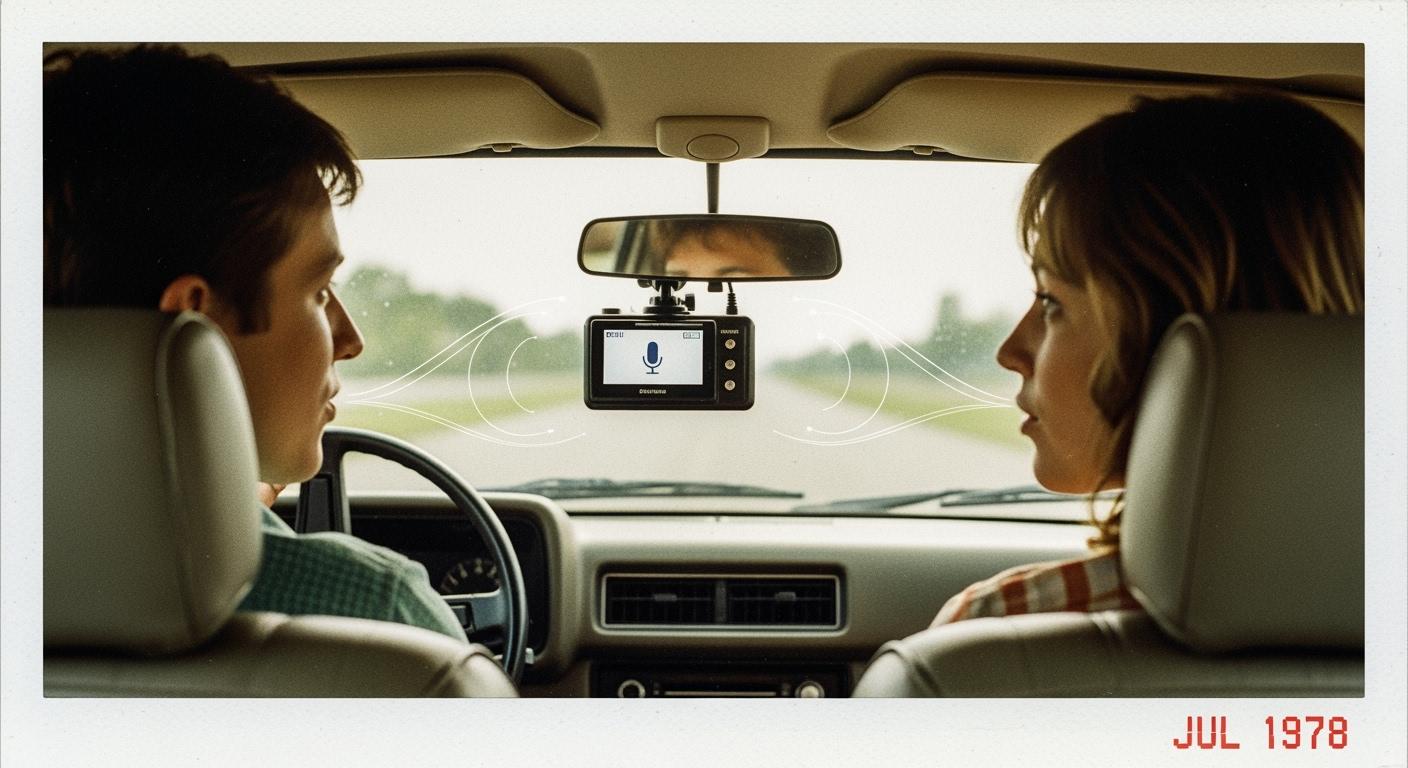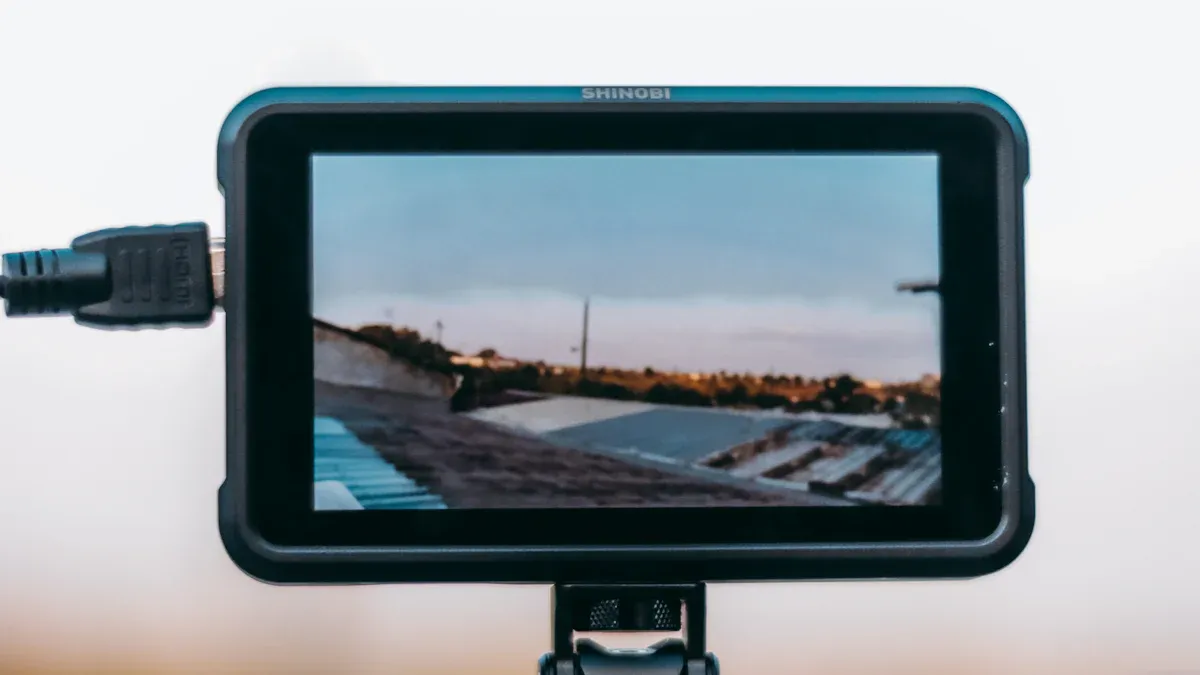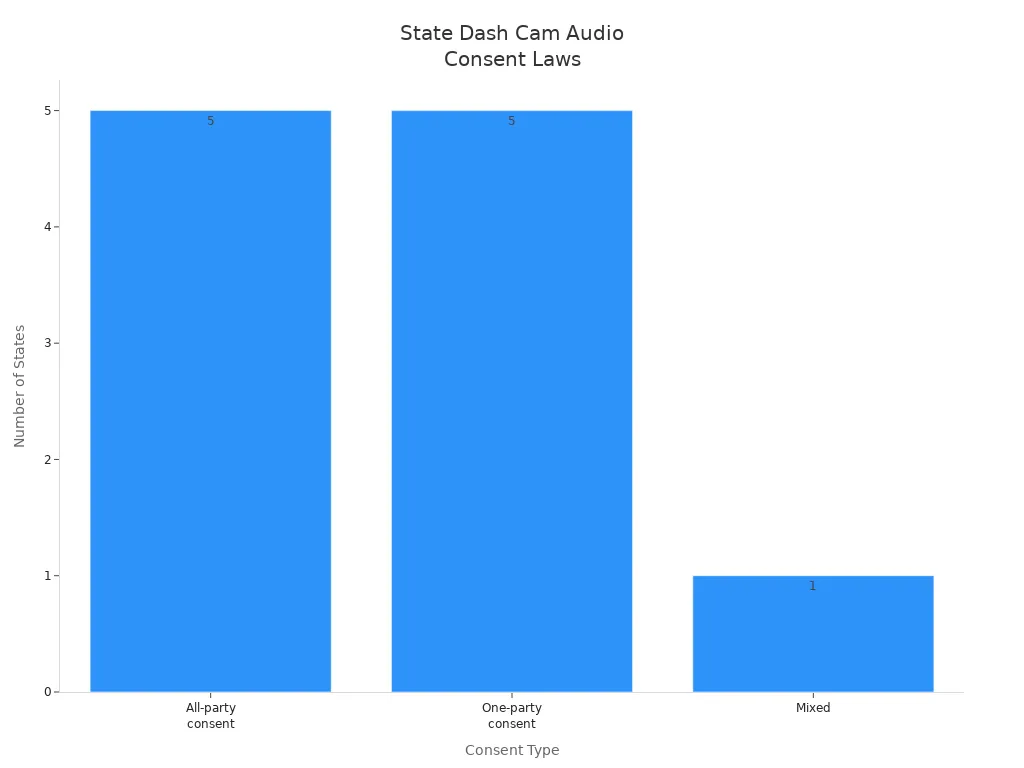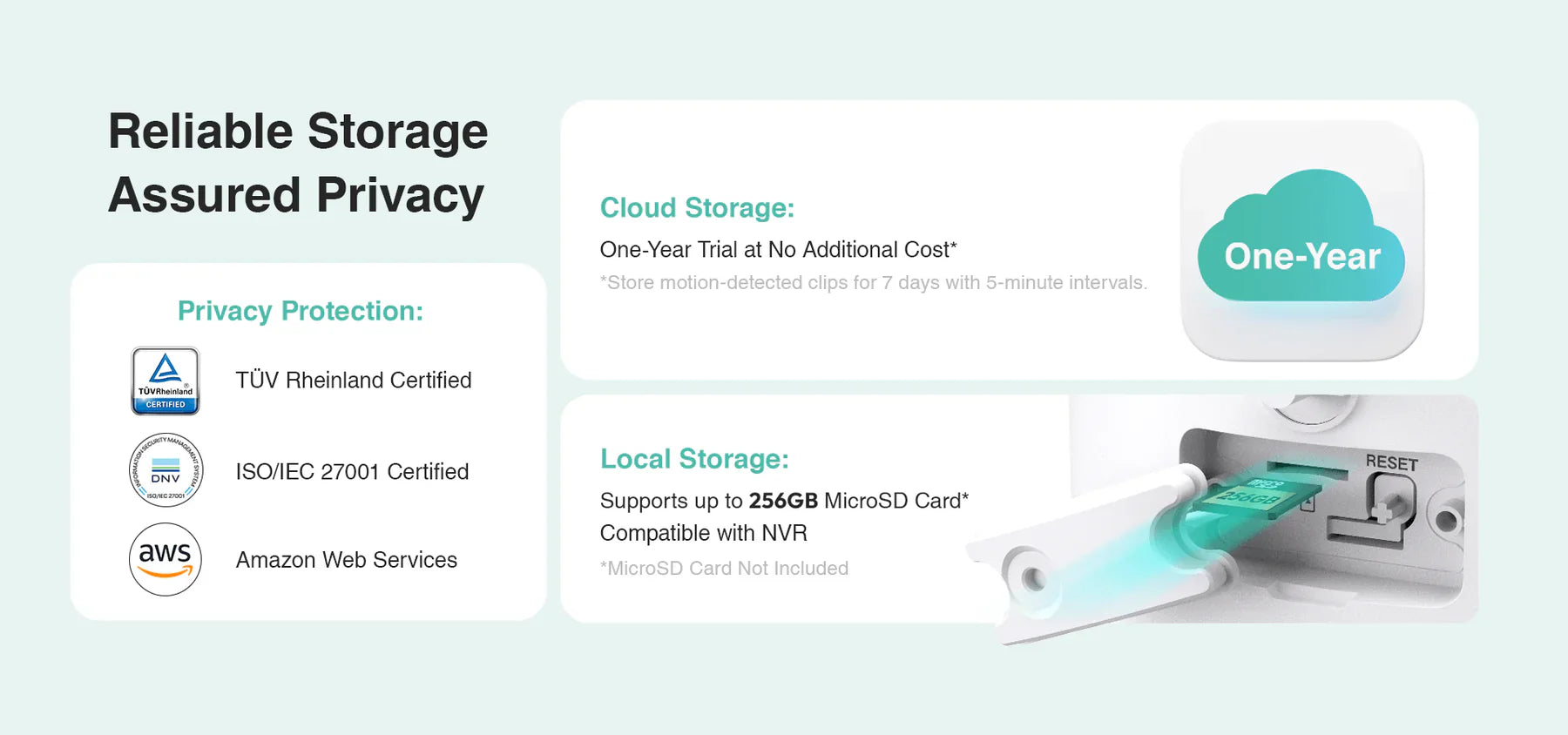
Most dash cams, like the Botslab Dash Cam G980H Pro, can record sound inside your car if they have a microphone. When you use a dash cam to record audio, you get more than just video. Voices and sounds can help show what happened during an event. Many people think dash cams do not record audio, but this feature is usually turned on by default. Audio recording can make videos more helpful for drivers and police, especially when clear sound is needed for proof. Always think about privacy and local laws before using audio recording.
Key Takeaways
- Dash cams can record sound inside your car if they have a microphone. This makes the video more useful. Always check your local laws about recording sound. This helps protect privacy and keeps you out of trouble. You can turn audio recording on or off in your dash cam's settings. This lets you choose what gets recorded. Good sound quality can help a lot during accidents. It makes it easier to explain things to police or insurance. Tell your passengers if you are recording sound. This builds trust and follows privacy laws.
How Dash Cams Record Audio

Built-In Microphones
When you use a dash cam, you might wonder how it picks up sound inside the car. Most dash cams come with a built-in microphone. This small part sits inside the device and listens to everything happening around it. You do not need to add anything extra. The dash cam does all the work for you.
- Dash cams use built-in microphones to record audio.
- The microphone captures voices, music, and other sounds inside the car.
- Some dash cams can even pick up noises from outside the vehicle if the windows are open or if the sound is loud enough.
The Botslab Dash Cam G980H Pro has a high-quality built-in microphone. It records clear audio, so you can hear conversations and important sounds in your recorded footage. This feature helps you understand what happened during an event, not just what you see on video.
Audio and Video Sync
You might ask, "How does the dash cam match the sound with the video?" The answer is simple. When the dash cam records, it saves both the video and the audio at the same time. This process is called syncing. You get a complete story with both pictures and sound.
If you ever need to review an event, synced audio and video make it easy. You can see what happened and hear what people said. This can help you explain things to police or insurance companies. The Botslab Dash Cam G980H Pro keeps your audio and video in perfect sync, so you never miss a detail.
Tip: If you notice that the audio and video do not match up, check your dash cam settings. Sometimes, a quick restart or a firmware update can fix the problem.
Audio Quality Differences
Not all dash cams record audio the same way. The quality of the audio recording can change based on a few things:
- The type of built-in microphone affects how clear the sound is.
- Dash cams with higher sample rates give you better audio recordings.
- Where you place the dash cam inside the car can change what the microphone picks up.
- The overall design of the dash cam also plays a role in audio quality.
The Botslab Dash Cam G980H Pro stands out because it uses advanced technology for both video and audio recording. You get crisp, clear audio recordings that make your videos more useful. If you want the best results, place your dash cam where it can easily pick up voices and sounds inside the car.
Some dash cams may sound muffled or pick up too much background noise. Others, like the G980H Pro, focus on giving you the best possible audio recording. This makes it easier to understand what happened during any event.
Remember, good audio recording can make a big difference when you need to review your dash cam footage. Always check your settings and test your dash cam to make sure it records audio the way you want.
Enabling or Disabling Recording Audio
Accessing Audio Settings
You might want to control when your dash cam records sound. Most dash cams make this easy. Start by turning on your dash cam and looking for the settings menu. You can usually find a button or a touchscreen icon that opens the menu. Once you are in the menu, look for an option called "recording audio" or "audio recording." This is where you can change how your dash cam handles sound.
If you use the Botslab Dash Cam G980H Pro, you can access the settings through the main menu on the device. The menu is simple and easy to use. Just tap the screen or use the buttons to scroll until you see the audio settings.
Turning Audio On or Off
Sometimes you want to record audio, and other times you want to turn off audio. Maybe you want privacy during a conversation, or you just do not need sound in your recorded footage. Here’s how you can turn off audio recording on most dash cams:
- Go to the settings menu.
- Find the "recording audio" or "audio recording" option.
- Select it, and you will see a choice to turn off audio or turn off audio recording.
- Confirm your choice.
On the Botslab Dash Cam G980H Pro, you can turn off audio recording with just a few taps. This helps you control what gets saved and when. If you want to turn off audio again later, just repeat these steps.
Tip: If you drive in places with strict privacy laws, you may want to turn off audio or turn off audio recording before you start your trip.
Troubleshooting Audio Issues
Sometimes, you might notice that recording audio does not work as expected. Maybe the dash cam records sound for a few minutes and then stops. Here are some things you can try:
- Check if you accidentally turned off audio recording in the settings.
- Adjust the recording cycle loop time. This can help fix problems with audio recordings stopping.
- Make sure your dash cam has a steady power source. Some users find that plugging the dash cam into the car’s cigarette lighter helps.
- Restart your dash cam to refresh the system.
If you follow these steps, you can fix most problems with recording audio. This way, you will always have clear audio recordings when you need them, especially if you want to capture important details during accidents.
Pros and Cons of Recording Audio
Benefits of Audio Recording
You may ask why you should use audio recording with your dash cam. There are some good reasons that can help keep you safe.
- You get the whole story. With video and sound, you can hear what people say. You also catch noises like horns or sirens.
- Insurance companies often use dash cam audio when you make a claim. The sound can show what happened and help solve arguments about accidents.
- If you drive for work or pick up people, audio recording can protect you. You have proof of what was said or done in your car.
- You can use saved footage to remember things you might forget. This includes directions or warnings from other drivers.
Tip: Audio recording can help you explain your side if something goes wrong on the road.
Drawbacks and Concerns
Audio recording has many benefits, but you should think about some problems too. These issues can affect your privacy and how you use your dash cam.
- Privacy is a big concern. Dash cams can record private talks, which might bother passengers or family.
- In some states, you need permission before you record sound. For example, Massachusetts does not allow recording someone without their okay. You could get in trouble if you break these rules.
- Most dash cams use memory cards that have limited space. If you do not save important audio, your dash cam might erase it. You could lose valuable recordings.
- Audio recordings can be private. If someone gets your files without your okay, they might hear things you did not want to share.
Note: Always check your local laws before using audio recording. Protect your privacy and the privacy of others.
Dash Cam Privacy and Legal Issues

If your dash cam records sound, you must think about privacy. Laws about recording audio can be confusing. Rules are different in each state. You should know these rules before you use your dash cam’s audio feature.
State and Local Laws
States have their own laws for recording sound in cars. Some states need everyone to say yes before you record. Other states only need one person to agree. Here is a table that shows what some states do:
| State | Consent Type | Description |
|---|---|---|
| California | All-party consent | Everyone in the car must say yes before you record sound. |
| Colorado | One-party consent | Only one person needs to say yes to record sound. |
| Connecticut | Mixed | All must agree for electronic messages; one person for talking in person. |
| Florida | All-party consent | Everyone in the car must say yes before you record sound. |
| Georgia | One-party consent | Only one person needs to say yes to record sound. |
| Illinois | All-party consent | Everyone in the car must say yes before you record sound. |

Always check your state’s laws before you use audio recording. If you break these rules, you could get fined or sued.
Consent and Notification
Getting permission is very important for privacy. Some places only need one person to say yes. Other places need everyone in the car to agree. Remember these things:
- In one-party consent states, you can record if you say yes.
- In all-party consent states, you must tell everyone and get their okay.
- Some places do not let you record sound in cars at all.
If you drive people for work or have passengers, tell them about the recording. This helps keep everyone safe and avoids problems.
Protecting Privacy
You should protect everyone’s privacy when using dash cams. Here are some easy tips:
- Ask passengers to write down that they agree before you record sound.
- Only record sound if everyone says yes.
- Turn off sound recording if someone does not want it.
- Keep your recordings safe so only you can see them.
Tip: Always talk to your passengers about your dash cam. Being honest about recording helps people trust you and keeps privacy safe.
Privacy matters to everyone. You do not want to record private things by mistake. If you use your dash cam the right way, you can keep yourself and your passengers safe from legal trouble and privacy problems.
Tips for Managing Dash Cam Audio
When to Use or Mute Audio
You might wonder when you should let your dash cam record sound and when you should mute it. The answer depends on where you drive and who rides with you. Some states have strict rules about recording voices inside the car. If you travel through places with all-party consent laws, it’s smart to mute the microphone or ask everyone before you record. Many drivers choose to keep audio off by default, just to stay safe. If you drive for work or have a lot of passengers, you can set up an opt-in or opt-out policy. Always check your dash cam’s settings before each trip.
Tip: Train yourself and anyone else who drives your car about the purpose of dash cams. This helps everyone understand why you use them and builds trust.
Storing Audio Files
Keeping your audio recordings safe is important. You should store files in a secure place, like a password-locked SD card or encrypted cloud storage. Try to keep important footage for at least 30 to 90 days, especially if it’s tied to an incident. Delete old or unneeded clips to make room for new ones and to follow privacy rules. If you need to share a file for legal reasons, make sure you can export it easily. Back up your files often so you don’t lose anything important.
- Use encrypted storage to protect your data.
- Keep backups for at least a month.
- Delete old clips you don’t need.
- Make sure only trusted people can access your files.
Responsible Use
Using dash cams the right way keeps you out of trouble. Always get clear consent from everyone if you plan to record audio, especially in states that require it. Let your passengers know when recording is on. You can put up a small sign or just tell them. Stay up to date on local laws and update your habits if rules change. If you record without permission, you could break the law or lose the right to use your footage in court.
Remember: Recording conversations without consent can cause legal problems. Respect everyone’s privacy inside the car.
You now know how dash cams record audio, how you can control this feature, and why privacy and legal rules matter. Here are the main points to remember:
- Dash cams capture conversations and sounds, which can help explain what happened during an incident.
- Recording audio may raise privacy concerns, so always check your local laws.
- You should review your dash cam’s features, like those on the Botslab Dash Cam G980H Pro, before turning on audio.
| Responsible Action | Why It Matters |
|---|---|
| Inform passengers about recording | Builds trust and avoids legal issues |
| Only record for safety or claims | Protects privacy and stays compliant |
Stay smart and use your dash cam audio features with care.
FAQ
Can I turn off audio recording on my dash cam?
Yes, you can. Most dash cams let you turn audio recording on or off in the settings menu. Just look for the audio option and select your preference.
Is it legal to record conversations in my car?
It depends on where you live. Some states need everyone’s consent before you record. Always check your local laws to stay safe.
Will recording audio use up my memory card faster?
Audio files are small compared to video. You won’t notice much difference in storage space. Video takes up most of the memory.
Do dash cams record sound outside the car, too?
Dash cams mainly pick up sounds inside your car. If your windows are open or a noise is loud, the microphone might catch it.





Teilen:
Simple Ways to Protect Solar Security Cameras from Harsh Weather
Top Dash Cams with Parking Mode for Every Budget